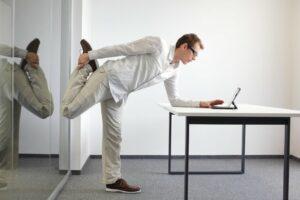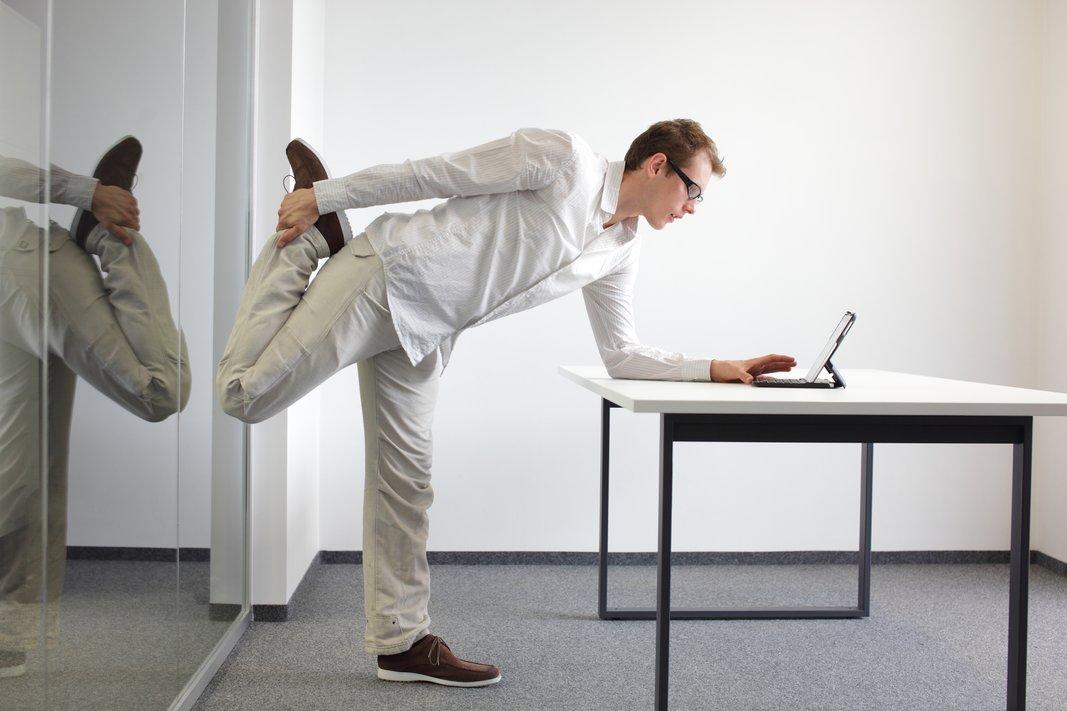Learn 10 simple stretches to relieve desk fatigue and improve your well-being! Say goodbye to aches and pains. Feel rejuvenated and energized throughout your workday.
Are you tired of feeling stiff and fatigued after sitting at your desk all day? Whether you work from home or in an office, prolonged sitting can take a toll on your body. But fear not! In this article, we will share with you 10 simple stretches that you can do right at your desk to relieve that pesky desk fatigue. So, say goodbye to those aches and pains and get ready to feel rejuvenated and energized throughout your workday!

Neck Stretches
Neck Rolls
One of the most effective stretches to relieve neck tension is the neck roll. Begin by sitting up straight in your chair with your feet planted on the ground. Slowly lower your chin towards your chest, feeling the stretch in the back of your neck. Gently roll your head to the right, bringing your right ear towards your right shoulder. Hold for a few seconds, then continue the motion by rolling your head back, bringing your chin towards the ceiling. Finally, roll your head to the left, bringing your left ear towards your left shoulder. Repeat this cycle for several rounds to release tension and improve circulation in your neck.
Neck Side Stretch
To stretch the sides of your neck, sit up straight with your shoulders relaxed. Place your right hand on the top of your head and gently tilt your head to the right, feeling the stretch in the left side of your neck. Hold the stretch for 15-30 seconds, then switch sides. Remember to breathe deeply and relax your shoulders throughout the stretch. This simple yet effective stretch helps to relieve stiffness and tightness in the neck and can be done multiple times throughout the day.
Chin Tucks
Chin tucks are excellent for targeting the muscles in the front of your neck, promoting good posture and alleviating neck pain. To perform a chin tuck, sit up straight and gently tuck your chin inwards towards your chest, like making a double chin. Hold this position for 5-10 seconds, then slowly release. Repeat this movement 10-15 times, focusing on keeping your shoulders relaxed and your spine tall. Chin tucks can be done discreetly while sitting at your desk, providing instant relief from neck strain caused by prolonged computer use.
Shoulder Stretches
Shoulder Rolls
Shoulder rolls help to release tension and increase mobility in your shoulder joints. Begin by sitting up straight with your feet flat on the ground. Lift both shoulders up towards your ears, then roll them back and down in a circular motion. Repeat this movement 10-15 times, switching directions halfway through. Shoulder rolls can be done at any time during the day and are particularly beneficial after long periods of sitting or typing. They promote relaxation and reduce stiffness in the shoulders, improving overall comfort and posture.
Shoulder Blade Squeeze
The shoulder blade squeeze stretch targets the muscles between your shoulder blades, releasing tension and improving upper body posture. Start by sitting up straight with your feet firmly planted on the ground. Draw your shoulder blades together behind you, as if you are trying to squeeze a pencil between them. Hold this position for 10-15 seconds, then release. Repeat the movement 10-15 times, focusing on maintaining a tall and relaxed posture. This stretch can be done throughout the day to counteract the effects of hunching over a desk.
Shoulder Shrugs
Shoulder shrugs are a simple yet effective stretch that can be done quickly and discreetly at your desk. Start by sitting up straight with your shoulders relaxed. Slowly lift both shoulders up towards your ears as high as you can, hold for a few seconds, then release them back down. Repeat this movement 10-15 times, focusing on fully relaxing your shoulders on the descent. Shoulder shrugs help to relieve tension and stiffness in the neck and shoulders, promoting better circulation and reducing discomfort caused by prolonged sitting.

Chest Stretches
Chest Opener Stretch
The chest opener stretch is perfect for counteracting the effects of sitting in front of a computer, which often leads to rounded shoulders and a tight chest. Stand up and place your hands behind your back, interlacing your fingers together. Gently lift your arms away from your body while keeping your back straight and your shoulders relaxed. You should feel a stretch in the front of your shoulders and chest. Hold the stretch for 15-30 seconds, then release. Repeat this stretch a few times to open up the chest and improve posture.
Chest Stretch with Towel
Another effective stretch to open up the chest involves using a towel or strap. Stand up straight and hold the towel with both hands, hands wider than shoulder-width apart. Raise your arms up and behind you, feeling the stretch in your chest and shoulders. If you are unable to reach the towel, simply use a longer towel or strap. Hold the stretch for 15-30 seconds, then release. This stretch is ideal for relieving tension in the chest and shoulders, making it easier to maintain an upright posture throughout the day.
Back Stretches
Seated Spinal Twist
The seated spinal twist is a fantastic stretch for the back that can be done right at your desk. Begin by sitting up straight with your feet flat on the ground. Place your right hand on the back of your chair and twist your torso to the right, gently pressing against the chair for resistance. Place your left hand on your right outer thigh to deepen the twist. Hold this position for 15-30 seconds, then switch sides. This stretch helps to release tension in the lower back and improves spinal mobility, reducing discomfort caused by sitting for long periods.
Upper Back Stretch
To alleviate upper back pain and tension, this stretch is highly effective. Sit up straight with your feet planted on the ground. Interlace your fingers in front of you, palms facing outwards. Inhale deeply as you reach your arms forward, rounding your upper back and feeling the stretch between your shoulder blades. Hold this position for 15-30 seconds, breathing deeply and relaxing your shoulders. Exhale as you release the stretch. This gentle stretch helps to improve posture and relieve tightness in the upper back, making it easier to maintain a comfortable sitting position.
Wrist Stretches
Wrist Circles
Wrist flexibility is often compromised when spending long hours at a desk. Wrist circles are a simple yet effective stretch to improve mobility and reduce discomfort in the wrists. Extend your right arm in front of you at shoulder height, palm facing down. Slowly rotate your hand in a circular motion, starting with small circles and gradually increasing the size. After 10-15 seconds, switch direction and repeat the motion with your left hand. Perform wrist circles multiple times a day to maintain flexibility and prevent stiffness in the wrists.
Wrist Flexor Stretch
To stretch the tendons and muscles in your wrists, sit up straight and extend your right arm in front of you, palm facing up. With your left hand, gently pull back your fingers to increase the stretch. Hold this position for 15-30 seconds, then release. Repeat the stretch with your left arm. This stretch is particularly beneficial for those who spend a lot of time typing or performing repetitive wrist movements. Stretching the wrist flexors helps to prevent discomfort and may reduce the risk of developing conditions such as carpal tunnel syndrome.
Hip Stretches
Seated Hip Opener
Sitting for prolonged periods can lead to tightness and discomfort in the hips. The seated hip opener stretch provides relief by targeting the hip flexors. Sit towards the edge of your chair with your feet flat on the ground. Place your right ankle on your left thigh, creating a figure four shape. Gently press down on your right knee to deepen the stretch, feeling the stretch in your right hip. Hold this position for 15-30 seconds, then switch sides. This stretch promotes hip flexibility and can be done throughout the day to counteract the effects of sitting.
Hip Flexor Stretch
The hip flexor stretch is particularly beneficial for those who spend a large portion of their day seated. Begin by standing up tall and stepping forward with your right foot, keeping your left foot planted behind you. Bend your right knee and gently lower your left knee towards the ground, feeling the stretch in the front of your left hip. Keep your upper body upright and your core engaged throughout the stretch. Hold for 15-30 seconds, then switch sides. This stretch helps to release tension in the hip flexors and improves overall hip mobility.
Leg Stretches
Hamstring Stretch
Hamstring tightness is a common issue for many individuals who sit for long periods. To stretch the hamstrings, sit towards the edge of your chair and extend your right leg in front of you, keeping your heel on the ground. Keep your back straight and gently hinge forward at the hips, reaching towards your toes. Hold this position for 15-30 seconds, then switch legs. If you are unable to reach your toes, use a strap or towel to assist you. Regularly stretching your hamstrings can help to alleviate lower back pain and improve flexibility in the legs.
Quad Stretch
The quad stretch targets the muscles at the front of your thighs and can be done right at your desk. Stand up straight and hold onto your chair or desk for balance if needed. Bend your right knee and bring your right foot towards your buttocks, grasping your ankle with your right hand. Gently pull your foot closer to your buttocks to deepen the stretch. Hold for 15-30 seconds, then switch sides. This stretch helps to release tension in the quadriceps and is particularly beneficial for individuals who spend a lot of time in a seated position.
Ankle Stretches
Calf Raises
To stretch and strengthen the calf muscles, start by standing up straight behind your chair or desk. Place your hands on the backrest or the surface for support. Slowly rise up onto your toes, lifting your heels off the ground as high as you can. Hold this position for a few seconds, then lower your heels back down to the ground. Repeat this movement 10-15 times to work the calf muscles and improve ankle flexibility. Calf raises can be done throughout the day to alleviate stiffness and increase blood flow in the lower legs.
Ankle Circles
Ankle circles are a simple and effective way to improve ankle mobility and reduce discomfort caused by sitting for extended periods. Sit up straight with your feet planted on the ground. Lift your right foot off the floor and gently rotate your ankle in a circular motion. Start with small circles and gradually increase the size. After 10-15 seconds, switch direction and repeat the circles with your left foot. Ankle circles can be done discreetly while sitting at your desk, offering a quick and easy way to keep your ankles flexible and prevent stiffness.
Eye Exercises
Palming
Eye strain is a common issue when spending long hours in front of a screen. Palming is a simple and effective exercise to relieve eye fatigue. Begin by rubbing your hands together for a few seconds to generate warmth. Cup your hands over your closed eyes, ensuring that there is no pressure on the eyeballs. Breathe deeply and relax for 1-2 minutes, allowing the warmth from your hands to relax the eye muscles. This exercise helps to reduce eye strain and promotes overall relaxation for the eyes. Palming can be done multiple times throughout the day for maximum benefit.
Near-Far Focus
To improve focus and reduce eye strain, the near-far focus exercise is highly beneficial. Sit up straight and hold your thumb in front of your face, about 10 inches away from your eyes. Focus on your thumb for a few seconds, then shift your gaze to an object in the distance, at least 20 feet away. Hold your focus on the distant object for a few seconds, then switch back to your thumb. Repeat this exercise 10-15 times, alternating between near and far focus. This exercise helps to relax and strengthen the eye muscles, improving visual comfort and reducing eye fatigue.
Breathing Exercises
Deep Belly Breaths
Deep belly breathing is a simple yet powerful technique to reduce stress and promote relaxation. Sit up straight in your chair and place your hands on your abdomen. Take a slow, deep breath in through your nose, allowing your belly to rise as you fill your lungs with air. Exhale slowly through your mouth, emptying your lungs while your belly falls. Continue inhaling and exhaling deeply, focusing on the rise and fall of your abdomen. Practice deep belly breathing for a few minutes whenever you feel overwhelmed or need to calm your mind and body.
Shoulder Breathing
Shoulder breathing is an effective exercise to release tension in the shoulders and upper body, promoting relaxation and reducing stress. Sit up straight with your shoulders relaxed. Place one hand on your abdomen and the other hand on your chest. Take a slow, deep breath in through your nose, allowing your abdomen to rise while keeping your chest still. Exhale slowly through your mouth, feeling the tension release from your shoulders as your abdomen falls. Repeat this breathing pattern for a few minutes, focusing on deepening your breath and relaxing your upper body. Shoulder breathing can be done anytime you need a quick break from work or to unwind after a long day.
Incorporating these stretches and exercises into your daily routine can significantly improve your comfort and well-being while working at your desk. Remember to listen to your body’s needs and adjust the stretches to your comfort level. Taking regular breaks to move and stretch is crucial for maintaining a healthy posture, reducing muscle tension, and preventing desk fatigue. So, take a few minutes throughout the day to perform these simple stretches and exercises, and say goodbye to the aches and pains associated with prolonged desk work. Your body will thank you!


